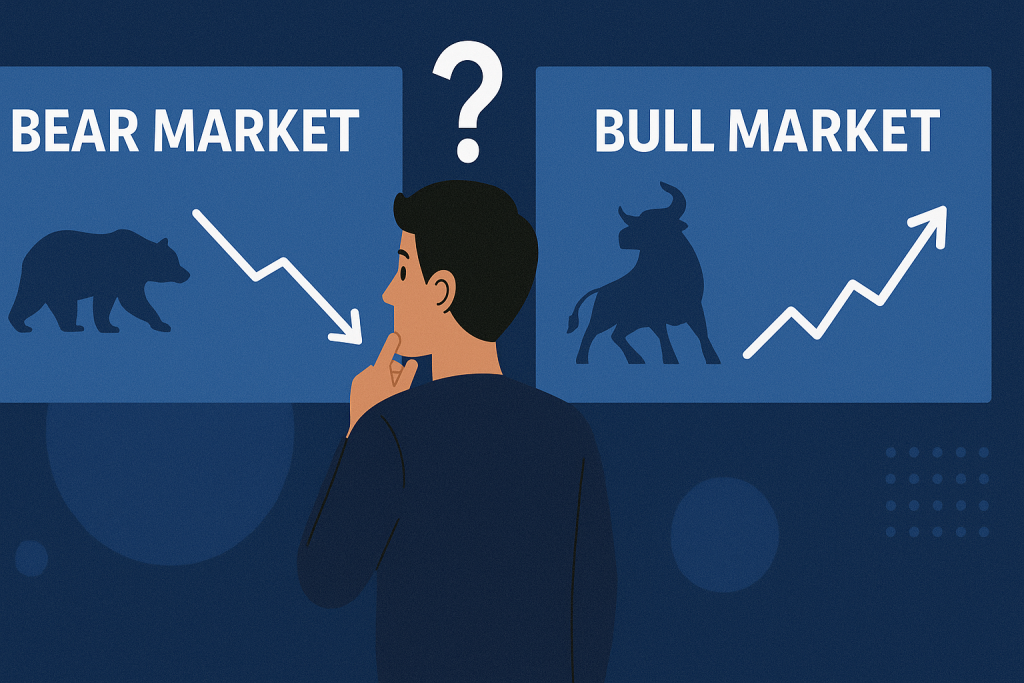If you’ve ever watched your crypto wallet shrink overnight, chances are you’ve had a run-in with a Bear Market. In the world of Cryptocurrency, this term isn’t just jargon—it’s a warning sign, a stress test, and sometimes a chance to buy low.
But here’s the thing: a Bear Market isn’t just about falling prices. It’s about psychology, patterns, and the way people react under pressure.
Understanding what a this is and how it behaves can help you make smarter decisions, especially in volatile spaces like the Crypto Market.
Whether you’re a seasoned trader or just starting out, knowing how to navigate this phase can be the difference between cutting your losses and making your comeback.
I’ve seen friends cash out at the bottom and kick themselves later. I’ve also seen quiet investors pick up solid coins during crashes and later celebrate life-changing returns.
That’s the real power of understanding a Bear Market.
What is Bear Market?

A Bear Market is a period when asset prices fall 20% or more from recent highs, often accompanied by widespread pessimism.
Think of it as the opposite of a bull market, where optimism and price surges reign. While this can affect any asset class, in Cryptocurrency, they tend to hit harder and move faster due to high volatility and emotional trading patterns.
In simpler terms, it’s when most people start panicking and selling, which just makes everything worse.
Other terms you might hear include “downturn,” “market crash,” or “recessionary phase.”
But don’t let the gloom fool you—Bear Markets are also a natural part of every financial cycle.
Breaking Down
To really understand a Bear Market, you need to know what causes it, how it behaves, and why it matters.
Prices don’t just fall on their own. Something spooks investors.
It could be a massive hack, like when Mt. Gox collapsed. Or a major company like FTX going bankrupt. Or even just rumors spreading across Reddit or Twitter.
People panic, and that panic spreads like wildfire.
You start seeing red candles everywhere. Big ones. The Coin Market tanks. Bitcoin drops 15% in a day. Altcoins? They bleed harder.
Retail investors sell out of fear. Whales manipulate dips. Bots follow momentum. It’s chaos.
But beneath all that, a Bear Market can actually reveal the true value of assets.
It shakes out projects with no use case. Memecoins with nothing behind them vanish. Hype fades, and the market begins to favor utility again.
Here’s something people don’t tell you: some of the best Blockchain projects were built in Bear Markets. They had time to develop without hype pressure.
This also resets expectations. You stop expecting instant 10x returns. You start thinking long-term.
For example, during the 2022, Bitcoin hit lows of $16,000. Most people ran for the hills. But those who stayed? They understood cycles.
They knew what was coming.
History
The term Bear Market has roots in early stock trading. Traders who expected prices to fall would “sell the bear’s skin before catching it”—basically, betting on losses.
That’s short selling in a nutshell. In Cryptocurrency, we’ve seen several brutal Bear Markets.
The crash after the 2013 bull run. The ICO bust in 2018. And the devastating blow from Terra Luna and FTX in 2022.
Each one had its own cause, but they all followed the same emotional pattern—euphoria, doubt, fear, panic, and finally… silence.
| Year | Trigger Event | Asset Affected | Price Drop |
|---|---|---|---|
| 2013–2015 | Mt. Gox hack | Bitcoin | ~85% |
| 2018–2019 | ICO bust | Altcoins, Bitcoin | 80–95% |
| 2022 | Luna/FTX collapses | Entire market | 70%+ |
Types
Cyclical
These occur as part of natural economic or market cycles. They’re expected and often followed by recovery.
Event-Driven
Triggered by a specific incident—like a regulatory crackdown or exchange hack—that shakes investor confidence.
Structural
These are the deepest cuts. Caused by long-term flaws in the system like massive fraud or structural inefficiencies.
| Type | Trigger | Duration | Severity |
|---|---|---|---|
| Cyclical | Economic cycle | Months to years | Moderate |
| Event-Driven | One-off events | Short-term | Sharp |
| Structural | Systemic flaws | Long-term | Severe |
How does Bear Market work?
A Bear Market works through a chain reaction. Fear sets in, people sell, prices fall, and more people panic. It’s a downward spiral.
Unlike bull markets, which build slowly and optimistically, bear markets fall fast and feed off uncertainty.
Technical indicators like moving averages, trading volumes, and RSI (Relative Strength Index) often confirm the trend.
But at the end of the day, it’s driven by human emotion and behavior—especially in the Crypto Market.
Pros & Cons
Before you swear off investing during a Bear Market, consider both sides.
| Pros | Cons |
|---|---|
| Lower prices = buying chances | Portfolio losses |
| Market corrections are healthy | Pessimism and panic |
| Exposes weak projects | Scares off new investors |
| Time to learn and strategize | Slower market activity |
Uses

A Bear Market may sound like a nightmare, but it’s not all doom and gloom. In fact, smart investors use this time wisely.
Building Strong Portfolios
Seasoned traders know that buying quality assets during a Bear Market often leads to big returns once the market rebounds.
It’s not glamorous, but it’s where wealth is made.
Learning & Research
When the market is quiet, it’s the perfect time to study projects, learn about Blockchain technology, and improve your investing skills.
There’s less noise, more time to think clearly.
Project Development
Bear Markets tend to filter out hype-driven ideas. Only serious builders remain, which leads to stronger innovations and more sustainable growth for the next cycle.
Strategic Exits & Re-entries
Some investors use the downturn to exit high-risk assets and re-enter safer positions.
Others stake or hold long-term, waiting patiently for recovery.
Resources
- Investopedia. What is a Bear Market?
- Forbes. What is a Bear Market and Why It Matters to You
- Fidelity. Bear Market Basics
- Business Insider. Understanding Bear Markets
- CFI. Bear Market Explained
